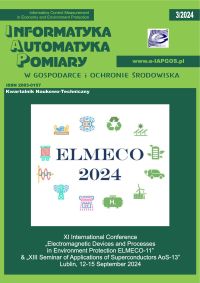TECHNIKI ROZPOZNAWANIA TWARZY
Olexandr N. Romanyuk
Vinnitsa National Technical University (Ukraina)
http://orcid.org/0000-0002-2245-3364
Sergey I. Vyatkin
Institute of Automation and Electrometry SB RAS, Novosibirsk (Federacja Rosyjska)
http://orcid.org/0000-0002-1591-3588
Sergii V. Pavlov
psv@vntu.edu.uaVinnitsa National Technical University (Ukraina)
http://orcid.org/0000-0002-0051-5560
Pavlo I. Mykhaylov
3D GNERATION GmbH, Dortmund (Niemcy)
http://orcid.org/0000-0001-5861-5970
Roman Y. Chekhmestruk
3D GENERATION UA, Vinnitsa (Ukraina)
http://orcid.org/0000-0002-5362-8796
Ivan V. Perun
3D GENERATION UA, Vinnitsa (Ukraina)
http://orcid.org/0000-0001-7402-4417
Abstrakt
Omawiany jest problem rozpoznawania twarzy. Rozważane są główne metody rozpoznawania. Użyta zostaje skalibrowana para stereo dla twarzy oraz obliczanie mapy głębokości poprzez algorytm korelacji. W wyniku takiego, uzyskiwana jest maska twarzy w wymiarze 3D. Użycie trzech antropomorficznych punktów, a następnie skonstruowany systemu współrzędnych zapewnia możliwość nakładania się przetestowanej maski.
Słowa kluczowe:
metody rozpoznawania pary stereo, mapa głębi, algorytm korelacji, funkcje perturbacji, działanie odejmowaniaBibliografia
Amann M. C., Bosch T. M., Lescure M., Myllylae R. A., Rioux M.:Laser ranging: a critical review of unusual techniques for distance measurement. Optical Engineering 40(1)/2001, 10–19, [http://doi.org/10.1117/1.1330700].
DOI: https://doi.org/10.1117/1.1330700
Google Scholar
Belhumeur P. N., Hespanha J. P., Kriegman D. J.: Eigen faces vs. Fisher faces: Recognition using Class Specific Linear Projection. IEEE Transactions on pattern analysis and machine intelligence 19(7)/1997, 711–720, [http://doi.org/10.1109/34.598228].
DOI: https://doi.org/10.1109/34.598228
Google Scholar
Butime J., Gutierrez I., GaloCorzo L., Flores C.: Espronceda. 3D reconstruction methods, a survey. Proceedings of the First International Conference on Computer Vision Theory and Applications, 2006, 457–463, [http://doi.org/0.5220/0001369704570463].
Google Scholar
Chien C. H., Aggarwal J. K.: Identification of 3D Objects from Multiple Silhouettes Using Quadtrees / Octrees. Computer Vision Graphics And Image Processing 36(2–3)/1986, 256–273.
DOI: https://doi.org/10.1016/0734-189X(86)90078-2
Google Scholar
Edwards G. J., Cootes T. F., Taylor C. J.: Face recognition using active appearance models. European Conference on Computer Vision, 1998, 581-595. [http://doi.org/10.1007/BFb0054766].
DOI: https://doi.org/10.1007/BFb0054766
Google Scholar
Jecić S., Drvar N.: 3D Shape Measurement Influencing Factors. NDT – Competence & Safety, Zagreb 2004, 109–116.
Google Scholar
Jolliffe I. T.: Principal component analysis, second edition. Springer, New York 2002.
Google Scholar
Lades M., Vorbruggen J.C., Buhmann J., et al.: Distortion Invariant Object Recognition in the Dynamic Link Architecture. IEEE Transactions on Computers 42(3)/1993 300–311, [http://doi.org/10.1109/12.210173].
DOI: https://doi.org/10.1109/12.210173
Google Scholar
Lawrence S., Giles C.L., et al.: Back. Face Recognition: A Convolutional Neural-Network Approach. IEEE Transactions on Neural Networks 8(1)/1997, 98–113, [http://doi.org/10.1109/72.554195].
DOI: https://doi.org/10.1109/72.554195
Google Scholar
Lipton L.: Foundations of the Stereoscopic Cinema – A Study in Depth. Van Nostrand Reinhold, New York 1982.
Google Scholar
Martin W. N., Aggarwal J. K.: Volumetric Descriptions of Objects from Multiple Views. IEEE Transactions on Pattern Analysis and Machine Intelligence 5(2)/1983, 150–158.
DOI: https://doi.org/10.1109/TPAMI.1983.4767367
Google Scholar
Nefian A. V.: A hidden Markov model-based approach for face detection and recognition. A Proposal for a Doctoral Dissertation. Georgia Institute of Technology 1998.
Google Scholar
Niem W.: Robust and Fast Modeling of 3D Natural Objects from Multiple Views. Proceedings Image and Video Processing II 2182/1994, 388–397.
DOI: https://doi.org/10.1117/12.171088
Google Scholar
Prabhu U., Seshadri K.: Facial Recognition Using Active Shape Models, Local Patches and Support Vector Machines, 2009.
Google Scholar
Reutebuch S. E., Andersen H., Mcgaughey R. J., Forest L.: Light Detection and Ranging (LIDAR): An Emerging Tool for Multiple Resource Inventory. J. For. 103(6)/2005, 286–292.
Google Scholar
Siudak M., Rokita P.: A survey of passive 3D reconstruction methods on the basis of more than one image. Machine Graphics & Vision 23(3/4)/2014, 57–11.
DOI: https://doi.org/10.22630/MGV.2014.23.3.5
Google Scholar
Szeliski R.: Shape from rotation. IEEE Computer Society Conference on Computer Vision and Pattern Recognition (CVPR'91), 1991, 625–630.
Google Scholar
Taigman Y., Yang M., et al.: Deep Face: Closing the gap to human level performance in face verification. IEEE Conference on Computer Vision and Pattern Recognition, 2014, 1701–1708.
DOI: https://doi.org/10.1109/CVPR.2014.220
Google Scholar
Vedula S., Rander P., Saito H., Kanade T.: Modeling, Combining, and Rendering Dynamic Real-World Events From Image Sequences. Proc. 4th Conference on Virtual Systems and Multimedia (VSMM98), 1998, 326–332.
Google Scholar
Vyatkin S. I., Romanyuk A. N., Gotra Z. Y., et al.: Offsetting, relations and blending with perturbation functions. Proc. of SPIE 10445/2017, 104452B.
DOI: https://doi.org/10.1117/12.2280983
Google Scholar
Vyatkin S. I., Romanyuk S. A., Pavlov S. V., Necheporyk M. L.: Face Identification Algorithms and its using. Modern Engineering and Innovative Technologies 5/2018, 111–115.
Google Scholar
Vyatkin S. I.: Complex surface modeling using perturbation functions. Optoelectronics, instrumentation and data processing 43/2007, 226–231.
DOI: https://doi.org/10.3103/S875669900703003X
Google Scholar
Vyatkin S. I.: Method of face recognition using of scalar perturbation functions and set-theoretic operation of subtraction. Optoelectronics, instrumentation and data processing 52(1)/2016, 1–7.
DOI: https://doi.org/10.3103/S8756699016010076
Google Scholar
Wiskott L., Fellous J. M., Kruger N., et al.: Face Recognition by Elastic Bunch Graph Matching. Proc. of International Conference on Image Processing 1/1997, 129–132, [http://doi.org/10.1109/ICIP.1997.647401].
DOI: https://doi.org/10.1109/ICIP.1997.647401
Google Scholar
Wójcik W., Pavlov S., Kalimoldayev M.: Information Technology in Medical Diagnostics II. Taylor & Francis Group, London 2019.
DOI: https://doi.org/10.1201/9780429057618
Google Scholar
Rawal R., Yadav V., Sharma S.: Radar – a brief study. International Journal of Innovative Research and Technology 1(12)/2015, 1017–1020.
Google Scholar
Autorzy
Olexandr N. RomanyukVinnitsa National Technical University Ukraina
http://orcid.org/0000-0002-2245-3364
Autorzy
Sergey I. VyatkinInstitute of Automation and Electrometry SB RAS, Novosibirsk Federacja Rosyjska
http://orcid.org/0000-0002-1591-3588
Autorzy
Sergii V. Pavlovpsv@vntu.edu.ua
Vinnitsa National Technical University Ukraina
http://orcid.org/0000-0002-0051-5560
Autorzy
Roman Y. Chekhmestruk3D GENERATION UA, Vinnitsa Ukraina
http://orcid.org/0000-0002-5362-8796
Statystyki
Abstract views: 550PDF downloads: 8585
Licencja

Utwór dostępny jest na licencji Creative Commons Uznanie autorstwa – Na tych samych warunkach 4.0 Miedzynarodowe.








